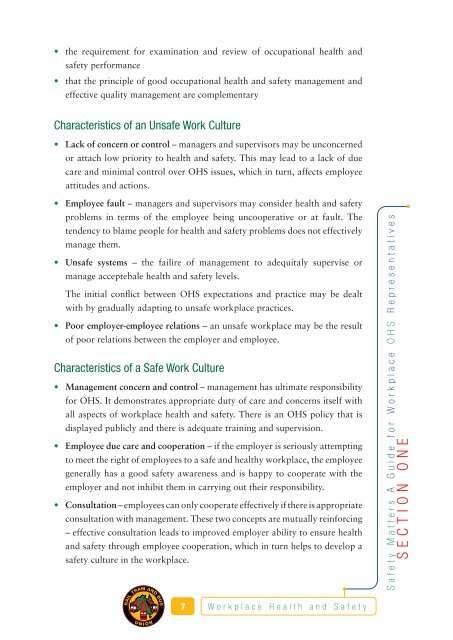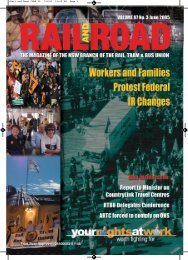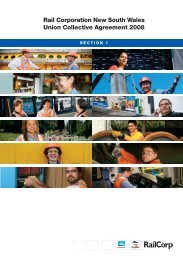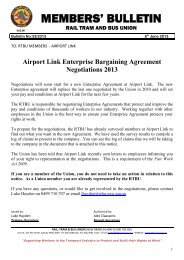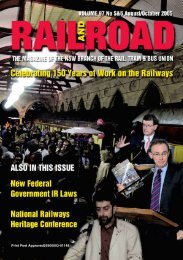Safety Matters - Rail, Tram and Bus Union of NSW
Safety Matters - Rail, Tram and Bus Union of NSW
Safety Matters - Rail, Tram and Bus Union of NSW
You also want an ePaper? Increase the reach of your titles
YUMPU automatically turns print PDFs into web optimized ePapers that Google loves.
• the requirement for examination <strong>and</strong> review <strong>of</strong> occupational health <strong>and</strong><br />
safety performance<br />
• that the principle <strong>of</strong> good occupational health <strong>and</strong> safety management <strong>and</strong><br />
effective quality management are complementary<br />
Characteristics <strong>of</strong> an Unsafe Work Culture<br />
• Lack <strong>of</strong> concern or control – managers <strong>and</strong> supervisors may be unconcerned<br />
or attach low priority to health <strong>and</strong> safety. This may lead to a lack <strong>of</strong> due<br />
care <strong>and</strong> minimal control over OHS issues, which in turn, affects employee<br />
attitudes <strong>and</strong> actions.<br />
• Employee fault – managers <strong>and</strong> supervisors may consider health <strong>and</strong> safety<br />
problems in terms <strong>of</strong> the employee being uncooperative or at fault. The<br />
tendency to blame people for health <strong>and</strong> safety problems does not effectively<br />
manage them.<br />
• Unsafe systems – the failire <strong>of</strong> management to adequitaly supervise or<br />
manage acceptebale health <strong>and</strong> safety levels.<br />
The initial conflict between OHS expectations <strong>and</strong> practice may be dealt<br />
with by gradually adapting to unsafe workplace practices.<br />
• Poor employer-employee relations – an unsafe workplace may be the result<br />
<strong>of</strong> poor relations between the employer <strong>and</strong> employee.<br />
Characteristics <strong>of</strong> a Safe Work Culture<br />
• Management concern <strong>and</strong> control – management has ultimate responsibility<br />
for OHS. It demonstrates appropriate duty <strong>of</strong> care <strong>and</strong> concerns itself with<br />
all aspects <strong>of</strong> workplace health <strong>and</strong> safety. There is an OHS policy that is<br />
displayed publicly <strong>and</strong> there is adequate training <strong>and</strong> supervision.<br />
• Employee due care <strong>and</strong> cooperation – if the employer is seriously attempting<br />
to meet the right <strong>of</strong> employees to a safe <strong>and</strong> healthy workplace, the employee<br />
generally has a good safety awareness <strong>and</strong> is happy to cooperate with the<br />
employer <strong>and</strong> not inhibit them in carrying out their responsibility.<br />
• Consultation – employees can only cooperate effectively if there is appropriate<br />
consultation with management. These two concepts are mutually reinforcing<br />
– effective consultation leads to improved employer ability to ensure health<br />
<strong>and</strong> safety through employee cooperation, which in turn helps to develop a<br />
safety culture in the workplace.<br />
<strong>Safety</strong> <strong>Matters</strong> A Guide for Workplace OHS Representatives<br />
SECTION ONE<br />
RAIL<br />
TRAM AND BUS<br />
7<br />
Workplace Health <strong>and</strong> <strong>Safety</strong><br />
U N<br />
I O N


